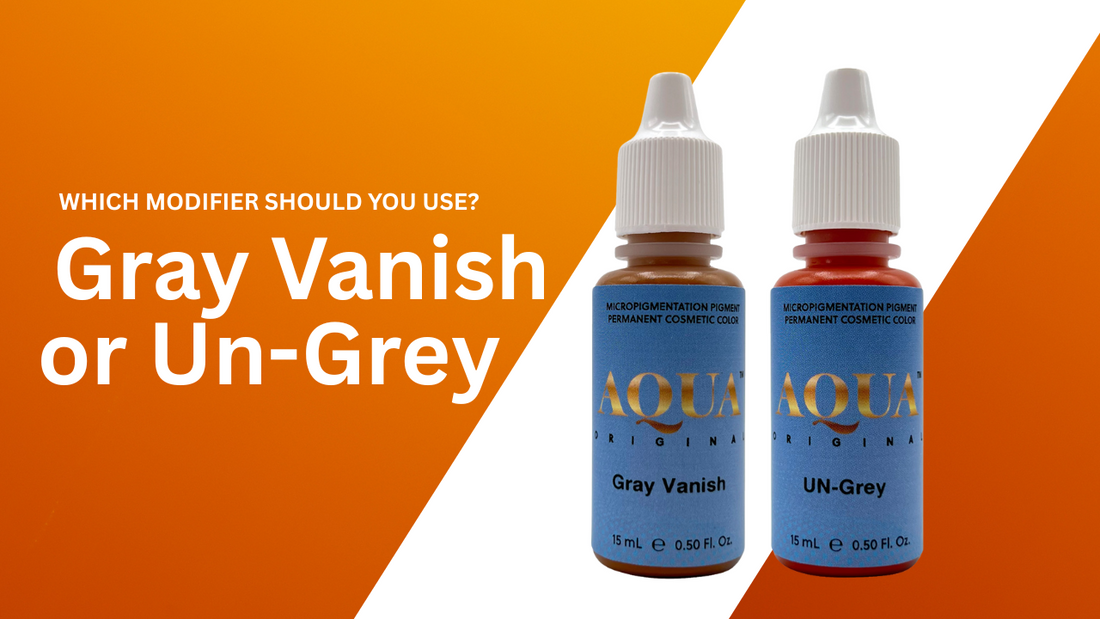
Gray Vanish vs. Un-Grey: Which Modifier Should You Use in PMU Color Corrections?
If you're a permanent makeup artist, chances are you've paused for a moment wondering: Gray Vanish or Un-Grey? With similar names and both being warm modifiers, these two correctors can be confusing. But don’t worry—we’re breaking it down Girlz Ink style so you can confidently choose the right pigment for your client's skin tone and correction needs.
Let’s get into it. 🔥
The Basics: What Are Gray Vanish and Un-Grey?
Both Gray Vanish and Un-Grey are inorganic warm modifiers used to correct and neutralize cool tones in the skin. They are not meant to be used on virgin skin alone—they’re added to another pigment to warm it up based on the client’s skin undertone and the saturation of the old tattoo or PMU.

Gray Vanish
🩷 Temperature: Warm
🩷 Base: Yellow + Orange (Inorganic)
🩷 Value: 3 (Medium)
Gray Vanish is best described as a golden warmth—think soft and sunny. It’s ideal for warming up lighter, medium, and dark colors, especially when you're working on slightly to moderately cool skin tones. This often includes Fitzpatrick I–III.
You can also use Gray Vanish to:
🩷 Neutralize medium saturation gray or blue brows
🩷 Help achieve a soft, healed brown tone
✨ Pro tip: If you’re unsure whether to use Gray Vanish or Un-Grey—Gray Vanish is the more subtle, golden sister. Start here for lighter or less stubborn cool tones.

Un-Grey
🩷 Temperature: Extremely Warm
🩷 Base: Orange (Inorganic)
🩷 Value: 3 (Medium)
Un-Grey brings the heat. It's a deep, rich orange designed for moderately to extremely cool skin tones—we’re talking about Fitzpatrick IV–V and clients with highly resistant, stubborn gray or blue pigment.
Use Un-Grey to:
🩷 Correct stubborn dark gray, charcoal, or deep blue brows
🩷 Add warmth to medium-dark and dark pigments
🩷 Warm up black eyeliner in clients with cool eyelid undertones (just a teeny amount!)
🚨 Warning: This modifier is extremely concentrated. A little goes a long way. Avoid using it on light skin or with blonde/light pigments.
When to Use Each Modifier in PMU Color Correction
| Modifier | Best For | Skin Tone | Pigment Use |
|---|---|---|---|
| Gray Vanish | Light to medium gray/blue brows | Fitz I–III (slightly/moderately cool) | Light to medium pigments |
| Un-Grey | Stubborn, dark gray/blue brows | Fitz IV–V (moderately/extremely cool) | Medium-dark to dark pigments + black liner (small amount) |
Key Reminders for Using Warm Modifiers
-
Never use modifiers alone on virgin skin
-
Only add as much warmth as the skin needs—too much can leave unwanted warmth in the healed result
-
Some clients may need no modifier at all—always assess the skin first
-
If you’re unsure, brush up on your PMU Color Theory
🎓 Need help identifying undertones or choosing the right modifier? Take our Color Theory Masterclass for a deep dive into pigment science.
Final Thoughts: Choose Wisely, Blend Warmth Thoughtfully
Both Gray Vanish and Un-Grey are amazing tools—but they have very different strengths. The key is understanding the level of coolness in the skin and the depth and stubbornness of the old pigment. When used correctly, they’ll help you achieve beautifully balanced, natural-looking healed results.

FAQs: Gray Vanish vs. Un-Grey in PMU
Q: Can I use Gray Vanish or Un-Grey by themselves?
A: No. These are modifiers, not standalone pigments for virgin skin.
Q: What’s the biggest difference between Gray Vanish and Un-Grey?
A: Gray Vanish is more golden and subtle, for slightly cool skin and lighter corrections. Un-Grey is deeper and richer for more stubborn, saturated corrections.
Q: Can I use Un-Grey in eyeliner work?
A: Yes, but in very small amounts—just enough to neutralize a cool undertone in black eyeliner.
Q: How do I know if I’m adding too much warmth?
A: If the skin doesn’t need the extra warmth, it won’t absorb it all—what’s left will show up in the healed result. Always assess the skin tone first.
Q: What if I still feel unsure?
A: No worries. Check out our Color Theory Course or reach out to our team—we’re here to help you slay every correction. 💪